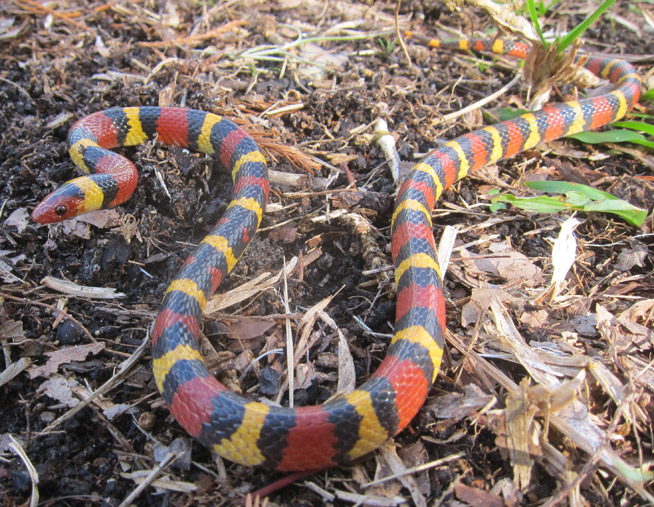
Biology:
The scarlet kingsnake (Lampropeltis elapsoides) is a colubrid snake that is native to the southeastern and eastern part of the continental United States. These snakes have a striking and easily recognizable color pattern consisting of alternating red, black and white or yellow bands. The red bands are the largest and comprise most of the snake’s color. The snout of the scarlet kingsnake is usually red.
A very small snake relative to others in the kingsnake group, scarlet kingsnakes only reach a maximum size of a bit over a meter in length. More typically scarlet kingsnakes are between 40 and 50 centimeters in length. Scarlet kinsnakes are long and slender, like other members of the kingsnake grouping.
This snake is famous for its resemblance to the much feared and deadly coral snake, which inhabits many of the same areas as the scarlet kingsnake. However, unlike the coral snake the scarlet kingsnake does not produce venom and is completely harmless to humans. The scarlet kingsnake likely evolved its resemblance to the coral kingsnake because doing so conferred a survival advantage from having potential predators avoid rather than attack the snake.
The best way to distinguish a scarlet kingsnake from a coral snake is to note the differences in the color patterns between the two snakes. Coral snakes have a color pattern in which the yellow banding touches the red banding. Scarlet kingsnakes are different because the black banding touches the red banding but the yellow or white banding only touches black banding.
A popular rhyme helps to keep this distinction in mind: “red on black, you’re okay jack; red on yellow, you’re a dead fellow.” Because the two snakes are so easily confused, if you have any doubt whatsoever as to whether a snake is a harmless scarlet kingsnake or a deadly coral kingsnake, it is best to keep plenty of distance and avoid the snake entirely.
To avoid trouble, read more about the Snake Rhyme Poem, and information about the Coral Snake Look Alike.
It should be noted that scarlet kingsnakes are capable of breeding with other subspecies in the same genus, and therefore some of the descriptions given above might not apply to all specimens.
Habitat:
The region where scarlet kingsnakes are known to reside consists of most of the states in the eastern portion of the United States, but especially in the southeastern states like Florida, Georgia, Alabama, South Carolina, and North Carolina. However, they can occasionally be found farther north towards the mid-Atlantic region.
The scarlet kingsnake’s preferred habitat is under loose leaf debris or under the rotting bark of pine trees. That is why most sightings occur under felled trees or backyards in suburban areas where humans have encroached on the natural habitat of the scarlet kingsnake.
Behaviour:
The scarlet kingsnake is fossorial. This means that it prefers to spend most of its time underground, out of the site of potential predators and away from other dangers.
The scarlet kingsnake is also nocturnal like many other snakes, meaning that it is most active at night. Nighttime is when scarlet kingsnakes are most likely to come out from their hiding places or burrows and be seen crossing roads or slithering into a suburban neighborhood. Night is also the time during which the scarlet kingsnake prefers to hunt.
Another factor making the scarlet kingsnake a rare find is that it is very shy. If a scarlet kingsnake detects a human or another large animal coming its way it will do its best to remain hidden.
Scarlet kingsnakes do not pose a serious danger to humans. Unlike the coral snakes that they resemble they do not produce any venom. The snakes would prefer to avoid humans entirely and choose to avoid a confrontation. If confronted and threatened by a human the scarlet kingsnake will most likely try to flee rather than put up a fight.
Diet:
The diet of the scarlet kingsnake consists mainly of other small reptiles, including frogs, toads, lizards, and other small snakes. Perhaps the largest portion of their prey comes in the form of the skink, which is a type of lizard that somewhat resembles a rather plump snake with disproportionately small legs for its rotund body.
Reproductive:
These snakes typically breed in springtime from March to June.
Scarlet kingsnakes are oviparous, meaning that the mothers lay eggs rather than giving birth to live young that hatched within the mother’s body. The eggs hatch a couple of months after the mother lays them.
Newly hatched scarlet kingsnakes are small, averaging around fifteen centimeters in length. However, they look almost identical to adult scarlet kingsnakes except the yellow portion of the banding tends to be more white.
Many people want to know how to kill a Scarlet Kingsnake, but you don't need to. The
best way to get rid of Scarlet Kingsnakes is to simply leave them alone. You can also
use a Scarlet Kingsnake trap to catch them - that's one of the best ways for how to
remove Scarlet Kingsnake. For more information, go to my
Snake Removal - How to Get Rid of Snakes home page.
If you need Scarlet Kingsnake removal in your city, I have friends that I have
personally trained in dozens of cities.